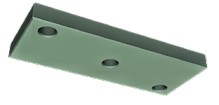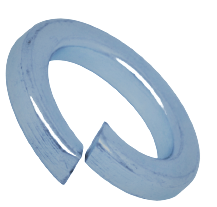Are you interested in learning more about Locking Devices?
Don’t worry, you’ve come to the right place. You will learn everything you need to know about it here, from the beginning to the conclusion. So, without further delays, Let’s get started…
Let’s start with fundamentals first…
What are Locking Devices?
Locking devices are used to keep rivets from loosening while the machine is running. When engines or equipment are turned on, vibrations can cause Nut and Bolts to loosen their grip. Fastener failure can be reduced with the use of mechanical locking devices.
Common thread fastenings typically remain tight under static loads, however several of these fastenings become loose when the machine is subjected to varied loads or vibrations.
Locking devices are used to lock the threaded fasteners mainly.
Fastener loosening is extremely dangerous and must be avoided. To avoid this, a variety of locking devices are available, some of which are discussed below:
Types of Locking Devices-
Here are some different types of Engineering Locking devices, Given below-
- Lock Nut
- Split Pin Nut
- Slotted Nut
- Castle Nut
- Sawn Nut
- Ring Collar Nut
- Simmonds Lock Nut
- Lock Plate
- Spring Lock Washer
- Pin Lock
Lock Nut-
A lock nut is an internally threaded fastener that can be used alone or in conjunction with another component to provide locking capabilities. When exposed to vibration, lock nuts are designed to prevent loosening.
A lock nut is a type of locking device that is commonly found in workshops. Standard nuts and ordinary nuts are tightened one by one in this method. The lock nut’s real form is hexagonal.

Split Pin Nut-
A combination of a split pin and a lock nut is the most effective locking fitting. The split pin is inserted into a groove on the nut’s surface after passing through a hole in the threaded bolt. Because the split pin prevents the nut from rotating, it cannot get lose.
This type of locking mechanism is commonly seen on high-speed rotating axles, where vibration can cause the lock nut to loosen over time. Locknuts loosening on some machinery can cause major tragedies.

Slotted Nut-
A slotted nut is a hexagon nut with castles and slots on the top that resemble a castle wall. It’s often called an axle nut because it’s where they’re most usually seen.
Slotted hex nuts are used with bolts that feature holes in the end through which a locking pin can pass to lock the nut into place and prevent it from rotating any further.
A split cotter pin, spring pin, or a safety wire are common locking pins.

Castle Nut-
Hexagonal nut and castle nut are comparable. There is a spherical cap above the head of the castle nut in which slots are cut, which distinguishes it from slotted nuts. Slots are carved into the upper surface of the slotted nut.
A hole is also in the bolt used with this nut. Both ends of the nut are distributed to the right and left after tightening it entirely using a split pin in the bolt and hole of the nut. This nut is commonly used in automobiles and railway engines due to the fact that it is not loose.

Sawn Nut-
This nut’s form is likewise comparable to hexagonal nut. A slot is cut in the side of the nut until it reaches the centre, and a hole larger than the square is made in the upper portion of the nut to be placed in the upper part of the nut.
The screw is inserted, and a threaded hole is drilled in the half of the nut’s bottom. After tightening the nut on the bolt, the screw is inserted into the hole, causing the upper and lower parts of the nut to be forced together.
It exerts pressure on the bolt’s thread and thus preventing the nut from loosening.

Read Also- The Splines Key
Ring Collar Nut-
This nut’s form is likewise comparable to hexagonal nut. The bottom section is cylindrical as well. The cylindrical section has grooves carved into it in the middle.
The screw’s end is also the same size as the groove’s diameter. The end of the screw fits right into that groove when it is tightened on the threaded hole. As a result, the nut is not loose.

Simmonds Lock Nut-
This nut has a collar on top of it that is cast with the nut. Place the nylon collar in the collar. Whose interior diameter is less than the bolt’s diameter. When the nut is tightened, the threaded end of the bolt secures the thread in the ring, preventing the nut from opening.

Lock Plate-
The lock or stop plate has slots carved into it and the slots are designed in such a way that the nut fits firmly when tightened. Because the pieces connecting the fit plate to the screw are securely fastened, there is no risk of the nut opening.

Spring Lock Washer-
The nut is tightened by inserting a washer between the nut’s surface and the washer. When the nut is tightened, the washer prevents the nut from opening again.

Pin Lock-
The pin with one face or the square without the head is tightened while tightening the nut in this way. As a result, there’s no need to be concerned about the nut opening.

Wrapping Up-
That’s all I have for now in the segment of Locking Devices. I hope you enjoyed your time here in this brief post.
If that’s the case, consider sharing with your friends, colleagues, or those in need to help spread the word.
Below are some sharing options.
Do you want to discover more? Here are a few articles to think about:
11 Types of rivets & Their Basic uses with Diagram
Ten Different Types of Spring and its Applications’
Cotter Joint: Definition, Types, Applications, Advantages, Disadvantages
Shaft Key- Types, Advantages and Disadvantages
Thank you for coming. I look forward to seeing you in the next segment.

Abhishek Tiwary is a blogger by passion and a Quality Engineer by profession. He completed his B.Tech degree in the year 2017. Now working in a reputed firm. He loves to share his knowledge with others.



